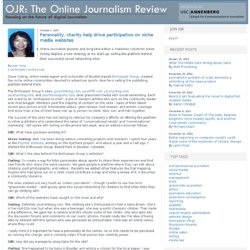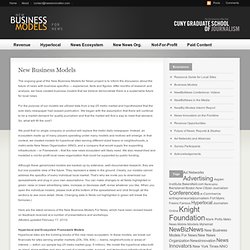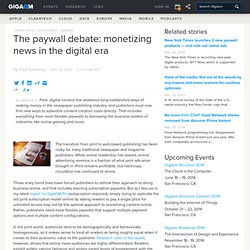

Successful Hyperlocal - Backyard Chickens! Posted 1/10/12 • Last updated 12/28/13 • 12,736 views History of the BackYard Chickens website Back in 1999 a few baby chicks were brought home from a kindergarten class. Personality, charity help drive participation on niche media websites. Steve Outing, online media expert and co-founder of Boulder-based Enthusiast Group , created five niche online communities devoted to adventure sports.

Now he is selling the publishing platform behind them. The Enthusiast Group’s sites, yourclimbing.com , yourMTB.com , yourcycling.com , yourrunning.com , and yourhorsesports.com , fuse grassroots media with social networking. Each site is led by an “enthusiast-in-chief”, a pro or semipro athlete who acts as the community leader and chief blogger. What is the best way to monetize news content outside of advertising. New media business models for news. New Business Models. The ongoing goal of the New Business Models for News project is to inform the discussion about the future of news with business specifics — experience, facts and figures.

After months of research and analysis, we have created business models that we believe demonstrate there is a sustainable future for local news. For the purpose of our models we utilized data from a top-25 metro market and hypothesized that the sole daily newspaper had ceased publication. We began with the assumption that there will continue to be a market demand for quality journalism and that the market will find a way to meet that demand. 5 Ways to Monetize the Future of News Media. This series is supported by The Poynter Institute’s Mobile Media blog – your guide to the intersection of mobile and media.

Sign up to receive the blog in newsletter format and be entered into a drawing to win an iPad at Poynter.org/ipadgiveaway. News media — including newspapers, news weeklies and TV news programs — was struggling long before the 2008 financial crisis and subsequent recession. It was a struggle, however, that many investors in 2006 and 2007 perceived as merely a temporary setback — a setback they attempted to capitalize on by snatching up seemingly undervalued media companies.
In 2006, newspaper publisher McClatchy acquired what was then the second largest newspaper publisher in the U.S., Knight Ridder, for $4.5 billion in cash and also financed $2 billion of the company's debt. Making money from journalism: new media business models (A model for the 21st century newsroom pt5) In the final part of the Model for the 21st Century Newsroom I look at how new media has compounded problems in news organisations’ core business models – and the new business models which it could begin to explore.

Let’s start by looking at the traditional newspaper business model. This has rested on selling, in a broad simplification, three things: Advertising. Put more explicitly: selling readers to advertisers.Selling content to readers, and, twinned with that:Selling the delivery platform to readers – i.e. the paper Developments in the past few decades have eaten into each of those areas as follows: A rise in alternative channels (radio, TV, direct mail, web, mobile) has reduced newspapers’ market share of advertising.
Newspapers: Building Digital Revenues Proves Painfully Slow. Also, as we and others have predicted, some of the independent, mostly nonprofit local news websites experienced setbacks as their initial foundation and benefactor launch-funding ran out. Both Voice of San Diego and the Center for Public Integrity began 2012 with layoffs. San Francisco Bay Citizen’s angel, financier Warren Hellman, died in December 2011 and the operation is being merged with the Center for Investigative Reporting. The Chicago News Cooperative, which like Bay Citizen had contributed regional content to The New York Times, ran out of money and ceased operations in February 2012.
Once again, though, this sector is not going away and many of the sites look to be sustainable if unlikely to expand greatly. But looking just at news competitors like Patch or a vigorous independent news site like MinnPost or the mass of localized special interest sites is far too narrow a frame of reference. The continuing declines weaken what newspapers can charge for advertising. The paywall debate: monetizing news in the digital era.
The transition from print to web-based publishing has been rocky for many traditional newspaper and magazine publishers.

While online readership has soared, online advertising revenue is a fraction of what print ads once brought in. Print remains profitable, but hard-copy circulation has continued to shrink. Those scary trend lines have forced publishers to rethink their approach to doing business online, and that includes erecting subscription paywalls. But as I discuss in my latest report for GigaOM Pro (subscription required), simply trying to replicate the old print subscription model online by asking readers to pay a single price for unlimited access may not be the optimal approach to monetizing content online.
Rather, publishers need more flexible paywalls that support multiple payment options and multiple content configurations. Digital transition — as paywalls emerge, what does the evidence tell us? - The Sydney Morning Herald, The Australian Financial Review, The Australian, subscriptions, print media, paywalls, page impressions, iPad, digital media. Rethinking the news model.